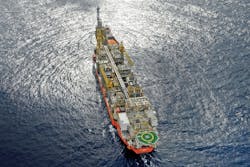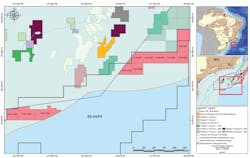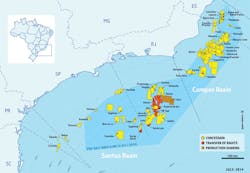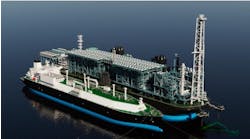Brazil is driving full steam ahead with reforms of its hydrocarbons sector. Latest proposals include scaling back on local content demands, liberalizing the gas market, and pushing forward field sales in order to bring in new investors. The measures are aimed partly at helping Petrobras to further ease its debt and focus more on growth in the deepwater presalt plays. Speakers from the company, Shell and others outlined some of the developments earlier this year at the Brazil-UK Oil & Gas Seminar in London.
According to Décio Oddone, Director General of Brazil’s National Agency of Petroleum, Natural Gas and Biofuels (ANP), the country’s oil and gas sector has undergone major changes over the past three years in response to the events of 2014. At that point, Petrobras was in financial crisis due to a combination of crippling debt, a corruption scandal, the oil price crash, and the fact that the government had halted new bid rounds for the past five years. As a result, the number of new wells and activity in general off Brazil had plunged.
To reverse the decline the ANP, in concert with the government, began enacting a series of steps that included opening the presalt to new players and the staging of bid rounds on a more regular basis. The 2017 and 2018 bid rounds were an enormous success, Oddone claimed: “Wood Mackenzie stated that during 2016-18 there were around 100 bid rounds in 82 countries, which led to awards of 3,000 exploration blocks. Of these, only 72 were in Brazil – but those blocks attracted $7.5 billion out of the $9 billion bid worldwide. So, Brazil got 75% of the available finance from those deals. But that’s still not enough, so we must continue to do things in the right way.”
During the second half of this year ANP plans three licensing rounds, with bidding and awards scheduled for late in 2019. First will be the 16th Concession Bid Round, with 36 blocks on offer in the presalt across the southern Camamu-Almada, Campos, Jacuípe, Pernambuco-Paraíba and Santos basins, plus further blocks off northeast Brazil. The focus of the 6th Production Sharing Round will be on the most attractive presalt blocks in the Aram, Bumerangue, Cruzeiro do Sul, Norte de Brava, and Sudoeste de Sagitário areas in the southeast. Finally, and potentially the most lucrative, will be the Transfer of Rights Round covering some of Brazil’s most sought-after presalt prospects.
Over time, the results of the 2016-19 auctions should transform Brazil’s oil and sector, Oddone suggested, more than doubling the country’s production while the number of presalt platforms operating off Brazil could be almost doubled, with major implications for the country’s supply chain. However, the ANP is also looking to attract new small to mid-size companies to some of Petrobras’ neglected shallow water and onshore prospects. So, a new regime has been established under which all the best relinquished areas will be made available on a permanent offer. Last year the ANP invited Petrobras to define which of its concessions it wanted to retain, and the response was that more than 77% could be sold off. “So, we may see an enormous rise in new companies operating in certain areas,” Oddone said, “and not just oil companies but also new service companies.”
In collaboration with Portuguese oil company GALP, the ANP has also been investigating Petrobras’ dominance of the Brazil’s natural gas market. The government has announced changes to make the business more dynamic, he added, encouraging competition in order to attract new players – including producers of gas in the presalt – in order to bring more gas to the country’s consumers rather than injecting most of it, as is currently still the case. “All these new measures, designed to attract all-comers, will put us in a situation Brazil has never been in before,” he concluded, “creating a more diverse and attractive oil and gas sector.”
Helping investors
Felipe Rodrigues Caldas Feres, Partner at Mattos Filho, Veiga Filho, Marrey Jr and Quiroga Advogados, gave a legal perspective on investment in Brazil’s oil and gas industry. In spite of the recent bid rounds, Petrobras retains a monopoly on the transportation infrastructure, Feres pointed out, which makes gas and fuel in Brazil extremely expensive. However, the new administration elected last year is looking to rein back on investments in hydropower and do more to harness the country’s offshore natural gas for power purposes.
“The new government’s policies are very pro-business,” he said, adding that these policies played a key part in the success of the latest bid rounds, particularly for the presalt areas. They include greater legal assurance to investors and tax incentives for importing more goods for E&P purposes.
Previous administrations leaned heavily toward nationalistic policies, increasing local content requirements for oil and gas projects, up to 65% in the case of the initial Libra block FPSO. But terms have now been relaxed, “as those in the know in Brazil are aware that the country doesn’t have the required shipyard capacity.” Other positive developments have been the release of historical geological data, previously only accessible by Brazilian companies, and a stronger arbitration policy, in particular concerning unitization of fields overlapping into adjoining blocks. This followed pressure from new investors.
As for selling assets, a necessity for Petrobras in order to bring down its debt, the company now has two ways of doing this, Feres said. One is via the country’s regular bid rounds and the other, following laws passed in 2016, is through doing business with other international oil companies. The Transfer of Rights round, expected to launch in October, will provide another means of sell-offs and could raise more than $100 billion in signing fees, making this the world’s largest auction of its type ever staged.
Another priority for the new administration is the midstream, increasing the use of Brazil’s gas. “Coupled with Petrobras selling assets, new regulations are coming to foster investment, and this is happening,” he said. “In addition, gas is being imported for re-gasification terminals, although these are thought of as a bridge for the new offshore infrastructure expected in the next few years.”
Changes are also under way to the government’s approach to R&D for the new bid rounds. “R&D, like local content, has been a failed policy,” Feres argued. “Simply giving money to universities in Brazil that don’t have good governance is a waste.”
Presalt milestones
Last year Petrobras marked 10 years of presalt production. According to Isabela Mesquita, Executive Manager Investor Relations, the company currently has 24 platforms operating in presalt areas, with 17 producing exclusively from the presalt and another six from the presalt and other layers. Presalt oil production reached a new high of 1.4 MMb/d, and 1.7 MMboe/d in total, she added. “But it has been a learning curve. The first well took 300 days to drill and complete; now the process takes less than 100 days. At the same time, Petrobras has cut its presalt lifting costs from $14/bbl to $7/bbl.
“The fields are giant resources with high-productivity wells, delivering light oil with low sulfur content. This used to be a frontier development activity, but not anymore.” Over the past year, she added, Petrobras had brought onstream seven more platforms in the presalt, comprising four in the Búzios transfer of rights area and two – P69 and P67 – on the Lula field, both in the Santos basin; and another in the Campos basin. The company is also investing heavily in the post-salt Campos basin – on Marlin and other producing fields, as well as in exploration. Last year Petrobras acquired stakes in 11 exploration blocks off Brazil. Mesquita predicted expenditure of $11 billion over the next five years, some of which will be allocated to concessions awarded under future bid rounds.
As output ramps up from wells connected to the seven new platforms, the company’s production should rise by 7% this year and then by a further 5% per year until 2023, by which point a further 11 new platforms should have entered service. Many will be on the presalt fields, with two replacing old installations on Marlin where Petrobras is looking to recover a further 1 Bbbl-plus.
In the Campos basin, Equinor, as a relatively new partner, is applying its North Sea experience to help increase recovery from the giant deepwater Roncador field. Petrobras sees potential to lift recovery on other mature fields to 50-60%, and is open to further partnerships, she added.
Gas initiatives
Ana-Paula Saraiva, Executive Manager, Acquisitions & Divestment at Petrobras, said the company had raised $50 billion in asset sales during 2016-2018, and is targeting a further $26-27 billion in divestments over the next five years. Among the most recently completed deals is the sale of a 90% interest in the Transportadora Associada de Gas (TAG) natural gas pipeline network to ENGIE and Canadian fund Caisse de Depôt et Placement du Quebec. But the main thrust of the future divestments will be in E&P, Saraiva said, with almost 70% of Petrobras’ more mature fields included in the program, from the northwest to the southeast of the country. “This is a great opportunity for other companies with a lower cost base to come to Brazil and invest in these assets that don’t fit Petrobras’ [forward plans], but which still have oil.”
Saraiva also touched on the latest initiatives to harness greater volumes of the offshore associated gas, particularly in the presalt fields where in some cases it represents 30% of the in-place resource. At present the country imports much of its gas needs via three LNG terminals and an overland pipeline from Bolivia. BP, ExxonMobil, and Shell are all investing in gas-to-power projects to monetize their associated gas in Brazil, and ExxonMobil is importing LNG from Qatar. But further measures are needed to increase competition and provide greater incentives to would-be gas producers. The presalt gas which, has a high CO2 and low sulfur content, will be expensive both to develop and to put in the required transportation infrastructure, she added; floating LNG vessels could be another option.
For Shell, gaining entry to the deepwater Libra field block in 2013 had been “a huge milestone,” said Fabio Gaspar, the company’s Tax Manager, Structuring & Advice and former Head of Upstream Tax for Brazil. “This was a play of around 10 Bbbl to be explored and developed which was a game-changer for Shell in Brazil. Then around two years ago, following the combination with BG Group, we have been able to access further joint ventures in the upstream space.”
Last year Shell invested $66 million in R&D in Brazil, and the company expects to spend $1-2 billion on its current assets going forward. In addition, it will consider the forthcoming bid rounds and opportunities for farm-ins and farm-outs.
“I also believe field decommissioning will be huge,” Gaspar said, “with Brazil being no.3 in the global $100-billion market, according to Wood Mackenzie.” •






